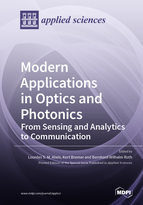Modern Applications in Optics and Photonics: From Sensing and Analytics to Communication
A special issue of Applied Sciences (ISSN 2076-3417). This special issue belongs to the section "Optics and Lasers".
Deadline for manuscript submissions: closed (29 February 2020) | Viewed by 52150
Special Issue Editors
Interests: photonic sensing within the areas of structural health monitoring, chemical sensing, biomedical sensing and wearable technology
Special Issues, Collections and Topics in MDPI journals
Interests: fiber-optic sensors; integrated optics; optic design; fiber-optic communication; point-of-care diagnostics
Special Issues, Collections and Topics in MDPI journals
Interests: laser sensing and spectroscopy; integrated polymer optics; fiber-optical sensing; optical technology for illumination; information; the life sciences; digital holography; fiber couplers; multi-physics optical simulations
Special Issues, Collections and Topics in MDPI journals
Special Issue Information
Dear Colleagues,
Optics and photonics are among the key technologies of the 21st century and offer the potential for novel applications in areas as diverse as sensing and spectroscopy, analytics, monitoring, biomedical imaging and diagnostics, as well as optical communication technology, among others. The high degree of control over light fields that is possible today, for example, by using micro- and nanooptics together with the tremendous capabilities of modern processing and integration technology, enables new optical measurement systems with enhanced functionality and unprecedented sensitivity. Such systems are thus attractive for a wide range of applications that have been previously inaccessible and may ultimately lead to the democratization of optics and photonics. This Special Issue aims to provide an overview on some of the most advanced application areas in optics and photonics and indicate the broad potential for the future. Research articles covering novel, highly-functional, and intelligent optical systems and their applications are invited to contribute.
Individual topics of interest include but are not limited to the following:
- Biosensors
- Fiber optic sensing
- Surface plasmon resonance sensors
- Optofluidic systems
- Distributed sensing
- Integrated micro- and nanooptic devices
- Structural health monitoring
- Optical analytics and metrology
- Medical diagnostics and monitoring
- Wearable optics
- Mode-selective fiber couplers
- Optics for communication technology
Dr. Lourdes Shanika Alwis
Dr. Kort Bremer
Prof. Dr. Bernhard Wilhelm Roth
Guest Editors
Manuscript Submission Information
Manuscripts should be submitted online at www.mdpi.com by registering and logging in to this website. Once you are registered, click here to go to the submission form. Manuscripts can be submitted until the deadline. All submissions that pass pre-check are peer-reviewed. Accepted papers will be published continuously in the journal (as soon as accepted) and will be listed together on the special issue website. Research articles, review articles as well as short communications are invited. For planned papers, a title and short abstract (about 100 words) can be sent to the Editorial Office for announcement on this website.
Submitted manuscripts should not have been published previously, nor be under consideration for publication elsewhere (except conference proceedings papers). All manuscripts are thoroughly refereed through a single-blind peer-review process. A guide for authors and other relevant information for submission of manuscripts is available on the Instructions for Authors page. Applied Sciences is an international peer-reviewed open access semimonthly journal published by MDPI.
Please visit the Instructions for Authors page before submitting a manuscript. The Article Processing Charge (APC) for publication in this open access journal is 2400 CHF (Swiss Francs). Submitted papers should be well formatted and use good English. Authors may use MDPI's English editing service prior to publication or during author revisions.
Keywords
- fiber optical sensing
- biosensing
- optofluidics
- integrated optics and photoncis
- optical analytics
- medical imaging and diagnostics
- optical communication technology
- distributed sensing








